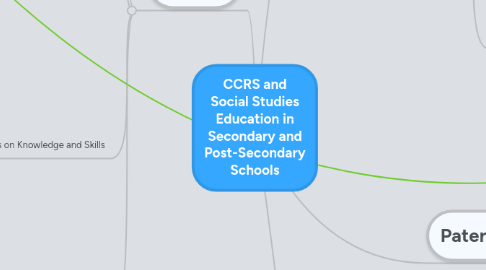
1. Realism
1.1. Reality can be Defined
1.1.1. Learned by studying the material world
1.1.1.1. Reality can be clearly defined and quantified
1.1.1.2. Study is free of dispositions and values, it is a reflection of reality that exists
1.1.2. Teaching and educational practice can be understood as a science
1.1.2.1. Students knowledge, learning, and effectiveness of education can be quantified
1.1.2.2. Education should be data-driven, like the study of natural sciences
1.1.2.2.1. data is value-neutral
1.1.2.2.2. hypothesis can be empirically tested and studied
1.1.2.3. See this in education with increase of research and reliance on research based methods to drive educational reform
1.2. Education Should be Practical
1.2.1. Education is to teach students the kinds of things they need to survive
1.2.1.1. This is especially applicable in a changing economy
1.2.1.1.1. Significant emphasis on Math, Science, English, and Social Studies, the "Core" subjects most practical for economic success
1.2.1.2. Studies should be practical for future use
1.2.1.2.1. This hits to the heart of the purpose of the CCRS. Standards to prepare students, pragmatically, for future college or career
1.2.1.3. Otherwise the child may become a liability (rather than an asset) to society
1.2.1.4. Only need to teach the "essential" things
1.2.1.4.1. Commitment to fundamental values
1.2.1.4.2. Commitment to fundamental "works"
1.3. Focus on Knowledge and Skills
1.3.1. an attempt to "raise up" the "dull and average student" (Whitehead)
1.3.1.1. worried about the watering down of education
1.3.2. An attempt to define what needs to be known by members of the society (E.D. Hirsch)
1.3.3. Prevailing philosophy in many schools, especially public schools, today
1.3.4. Standards movement
1.3.4.1. Gives ability to quantify learning and educational institutions
1.3.4.2. Standards are a reflection of reality
1.4. Realism as Control
1.4.1. One view of reality has a bias towards order and control
1.4.1.1. World exists in one way, as objectively discovered
1.4.1.2. Students, teachers, educational systems are subservient to these ideas
1.4.1.3. Standards can be used to control
2. Transparency
2.1. Weakens control
2.1.1. Forced transparency weakens trust
2.1.1.1. Trust is lost, honesty is lost
2.1.1.1.1. Trust can be lost between institutions, policy makers and bureaucrats
2.1.1.2. Increased compliance increases predictability
2.1.1.2.1. Results of increased transparency will reflect overtly stated goals and may not reflect what is best for students or schools
2.1.1.3. Increases surface level compliance to the letter of the law
2.2. Increases control
2.2.1. Discourages what is out of the norm, (or may discourage teaching that is different than the norms of interest groups)
2.2.1.1. may limit academic freedom?
2.2.1.2. may de-politicize teaching?
2.2.1.3. may limit controversial topics?
2.2.2. An agent of accountability to the public
2.2.2.1. democratic themes
2.2.2.2. themes of mis-trust
2.2.2.3. "sunshine" laws
2.2.2.4. State has a "legitimate interest in how teaching is conducted" John Sharp, Comptroller, 1996
3. Paternalism
3.1. Definition: Interference of one institution with another institution
3.2. Motivation for paternalism
3.2.1. Attempt by institutions to ensure that all students are successful at next institution
3.2.2. Motivated by the claim that the interfered institution will be better off
3.2.2.1. Issues of pragmatism
3.3. Power
3.3.1. May be against the will of subjected institution
3.3.2. Subjected institution may accept the interference willingly
3.3.2.1. subjected institution accepts the goals of paternalism
3.4. Paternalism as control
3.4.1. Powerful institution can define what skills and knowledge are necessary to learn by students in the subservient institution
3.4.2. Can define what skills and knowledge are most important
3.4.3. Can define pedagogical best practices in the subservient institution
4. Ahistoricism
4.1. Philosophers formulate theories, test theories, and then hold on the them
4.1.1. Most scientists today practice their profession ahistorically. They are Darwinists, but they don't read Darwin, discuss Darwin (Frazer, 2010)
4.2. HIstorians stand on the shoulders of giants, and understand that "we know better than our ancestors what they were talking about"
4.2.1. Could be described as "historiophobia" (Frazer, 2010)
4.2.2. Consistent reworking of history, "conversations with the re-educated dead"
4.2.2.1. as a way to assure ourselves that there is rational progress to civilization
4.2.2.2. process of correction or re-education is "rational reconstruction" (frazer, 2010)
4.2.3. The philosophical study of politics is a "progressive enterprise in which knowledge is cumulative."
4.2.3.1. The study of history exists to progress this useful knowledge further
4.2.3.2. The philosophical study of history has practical and purposeful application to the present
4.2.4. Most political questions are timeless
4.2.4.1. Answers to these questions are not timeless
4.3. Standards are an ahistorical approach to history.
4.3.1. Standards outline historical traditions and knowledge, leave the "thinking to ourselves"
